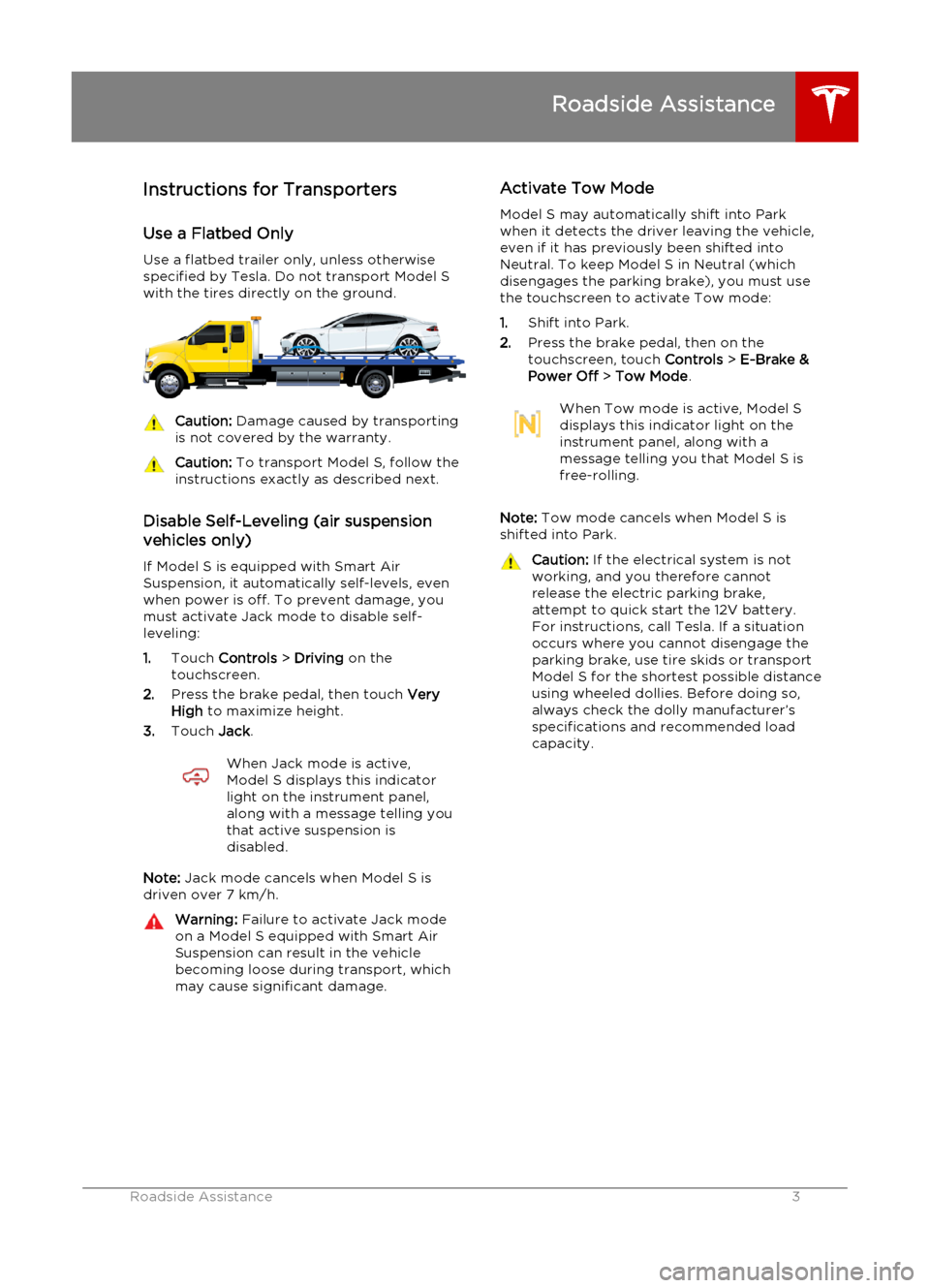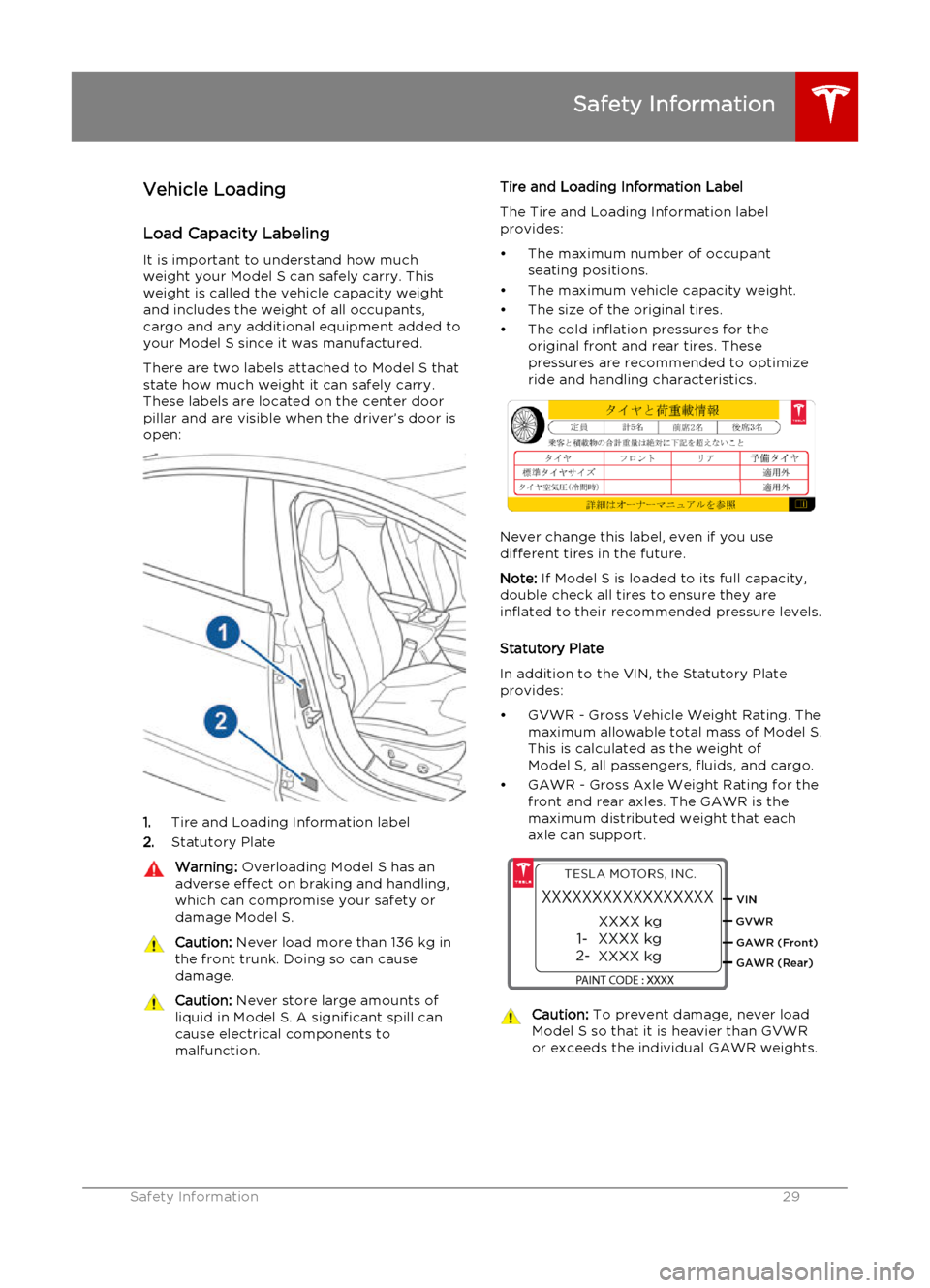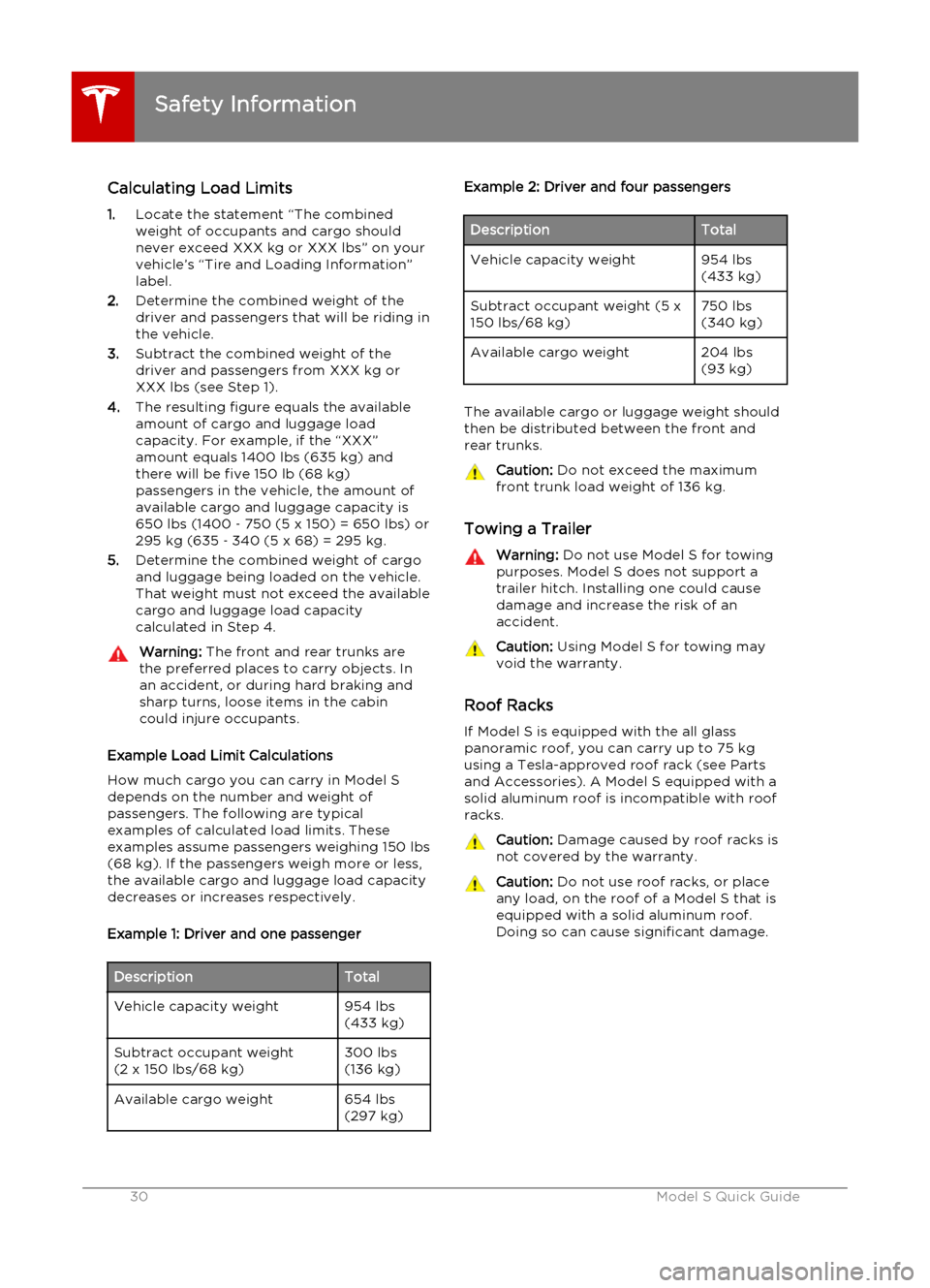load capacity TESLA MODEL S 2015 クイックガイド (in Japanese)
[x] Cancel search | Manufacturer: TESLA, Model Year: 2015, Model line: MODEL S, Model: TESLA MODEL S 2015Pages: 96, PDF Size: 2.86 MB
Page 5 of 96

Roadside Assistance......................2Contacting Roadside Assistance.......................... 2
Instructions for Transporters.................................. 3
Use a Flatbed Only 3Disable Self-Leveling (air suspension vehicles only) 3Activate Tow Mode 3Connect the Tow Chain 4Pull Onto the Trailer and Secure the Wheels 4
Safety Information..........................5Seat Belts....................................................................... 5
Wearing Seat Belts 5Wearing Seat Belts When Pregnant 6Seat Belt Pre-tensioners 6Testing Seat Belts 7Seat Belt Warnings 7
Child Safety Seats....................................................... 8
Guidelines for Seating Children 8Choosing a Child Safety Seat 9Seating Larger Children 11Installing Child Safety Seats 11Installing Seat Belt Retained Child Seats 11Installing ISOFIXChild Seats 12Attaching Upper Tether Straps 12Testing a Child Safety Seat 13Warnings - Child Safety Seats 13
Tesla Built-In Rear Facing Child Seats.............. 14
Usage Restrictions 14Opening 14Folding 15Seating a Child 16Warnings - Tesla Child Seats 17
Airbags.......................................................................... 18
Location of Airbags 18How the Airbags Work 19Types of Airbags 19Disabling the Passenger Front Airbags 20Inflation Effects 21Airbag Warning Indicator 21Airbag Warnings 21
Tire Care and Maintenance................................... 22
Maintaining Tire Pressures 22Inspecting and Maintaining Tires 23Replacing Tires and Wheels 24Using Tire Chains 25Tire Pressure Monitoring 25Understanding Tire Markings 27
Vehicle Loading.........................................................29
Load Capacity Labeling 29Calculating Load Limits 30Towing a Trailer 30Roof Racks 30
Disclaimers................................................................... 31
Vehicle Telematics/Data Recorders 31Quality Control 31
Declarations of Conformity.................................. 32
Key and Passive Unlocking System 32Tire Pressure Monitoring System 33Media Control Unit 33Radio Frequency Information 34
Reporting Concerns.................................................35
Contacting Tesla 35
Warranty..........................................36General Warranty Provisions............................... 36
Who is the Warrantor? 36What Vehicles are Covered? 36Multiple Warranty Conditions 36Limitations and Disclaimers 36Ownership Transfer 36Who Can Enforce this New Vehicle Limited Warranty? 37When Does the Warranty Period Begin and End? 37
Warranty Coverage................................................. 37
Basic Vehicle Limited Warranty 37Supplemental Restraint System Limited Warranty 37Battery and Drive Unit Limited Warranty 38
Exclusions and Limitations................................... 38
Warranty Limitations 38Additional Limitations and Exclusions 39Voided Warranty 40Damages 40
Obtaining Warranty Service................................ 40
Payment of Tax for Repairs 41Reasonable Time for Repairs 41Roadside Assistance (Japan) 41Modifications and Waivers 41
Dispute Resolution.................................................... 41Contents
Page 7 of 96

Instructions for Transporters
Use a Flatbed Only
Use a flatbed trailer only, unless otherwise specified by Tesla. Do not transport Model Swith the tires directly on the ground.Caution: Damage caused by transporting
is not covered by the warranty.Caution: To transport Model S, follow the
instructions exactly as described next.
Disable Self-Leveling (air suspension
vehicles only)
If Model S is equipped with Smart Air Suspension, it automatically self-levels, evenwhen power is off. To prevent damage, youmust activate Jack mode to disable self-
leveling:
1. Touch Controls > Driving on the
touchscreen.
2. Press the brake pedal, then touch Very
High to maximize height.
3. Touch Jack.
When Jack mode is active,
Model S displays this indicator
light on the instrument panel,
along with a message telling you
that active suspension is
disabled.
Note: Jack mode cancels when Model S is
driven over 7 km/h.
Warning: Failure to activate Jack mode
on a Model S equipped with Smart Air
Suspension can result in the vehicle becoming loose during transport, which
may cause significant damage.Activate Tow Mode
Model S may automatically shift into Park
when it detects the driver leaving the vehicle, even if it has previously been shifted intoNeutral. To keep Model S in Neutral (which
disengages the parking brake), you must use
the touchscreen to activate Tow mode:
1. Shift into Park.
2. Press the brake pedal, then on the
touchscreen, touch Controls > E-Brake &
Power Off > Tow Mode .When Tow mode is active, Model S
displays this indicator light on the
instrument panel, along with a
message telling you that Model S is
free-rolling.
Note: Tow mode cancels when Model S is
shifted into Park.
Caution: If the electrical system is not
working, and you therefore cannot
release the electric parking brake,
attempt to quick start the 12V battery.
For instructions, call Tesla. If a situation
occurs where you cannot disengage the
parking brake, use tire skids or transport
Model S for the shortest possible distance
using wheeled dollies. Before doing so,
always check the dolly manufacturer’s specifications and recommended load
capacity.
Roadside Assistance
Roadside Assistance3
Page 33 of 96

Vehicle Loading
Load Capacity Labeling It is important to understand how much
weight your Model S can safely carry. This weight is called the vehicle capacity weight
and includes the weight of all occupants, cargo and any additional equipment added toyour Model S since it was manufactured.
There are two labels attached to Model S that
state how much weight it can safely carry.
These labels are located on the center door
pillar and are visible when the driver’s door is
open:
1. Tire and Loading Information label
2. Statutory Plate
Warning:
Overloading Model S has an
adverse effect on braking and handling,
which can compromise your safety or
damage Model S.Caution: Never load more than 136 kg in
the front trunk. Doing so can cause
damage.Caution: Never store large amounts of
liquid in Model S. A significant spill can
cause electrical components to
malfunction.Tire and Loading Information Label
The Tire and Loading Information label provides:
• The maximum number of occupant seating positions.
• The maximum vehicle capacity weight.
• The size of the original tires.
• The cold inflation pressures for the original front and rear tires. These
pressures are recommended to optimize
ride and handling characteristics.
Never change this label, even if you use different tires in the future.
Note: If Model S is loaded to its full capacity,
double check all tires to ensure they are
inflated to their recommended pressure levels.
Statutory Plate
In addition to the VIN, the Statutory Plate provides:
• GVWR - Gross Vehicle Weight Rating. The maximum allowable total mass of Model S.
This is calculated as the weight of
Model S, all passengers, fluids, and cargo.
• GAWR - Gross Axle Weight Rating for the front and rear axles. The GAWR is the
maximum distributed weight that each
axle can support.
Caution: To prevent damage, never load
Model S so that it is heavier than GVWR
or exceeds the individual GAWR weights.
Safety Information
Safety Information29
Page 34 of 96

Calculating Load Limits
1. Locate the statement “The combined
weight of occupants and cargo should never exceed XXX kg or XXX lbs” on your
vehicle’s “Tire and Loading Information” label.
2. Determine the combined weight of the
driver and passengers that will be riding in
the vehicle.
3. Subtract the combined weight of the
driver and passengers from XXX kg or
XXX lbs (see Step 1).
4. The resulting figure equals the available
amount of cargo and luggage load
capacity. For example, if the “XXX”
amount equals 1400 lbs (635 kg) and there will be five 150 lb (68 kg)
passengers in the vehicle, the amount of
available cargo and luggage capacity is
650 lbs (1400 ‑ 750 (5 x 150) = 650 lbs) or
295 kg (635 ‑ 340 (5 x 68) = 295 kg.
5. Determine the combined weight of cargo
and luggage being loaded on the vehicle.
That weight must not exceed the available
cargo and luggage load capacity
calculated in Step 4.Warning: The front and rear trunks are
the preferred places to carry objects. In
an accident, or during hard braking and sharp turns, loose items in the cabin
could injure occupants.
Example Load Limit Calculations
How much cargo you can carry in Model S
depends on the number and weight of
passengers. The following are typical
examples of calculated load limits. These
examples assume passengers weighing 150 lbs (68 kg). If the passengers weigh more or less,
the available cargo and luggage load capacity decreases or increases respectively.
Example 1: Driver and one passenger
DescriptionTotalVehicle capacity weight954 lbs
(433 kg)Subtract occupant weight
(2 x 150 lbs/68 kg)300 lbs
(136 kg)Available cargo weight654 lbs
(297 kg)Example 2: Driver and four passengersDescriptionTotalVehicle capacity weight954 lbs
(433 kg)Subtract occupant weight (5 x
150 lbs/68 kg)750 lbs
(340 kg)Available cargo weight204 lbs
(93 kg)
The available cargo or luggage weight should
then be distributed between the front and
rear trunks.
Caution: Do not exceed the maximum
front trunk load weight of 136 kg.
Towing a Trailer
Warning: Do not use Model S for towing
purposes. Model S does not support a
trailer hitch. Installing one could cause
damage and increase the risk of an
accident.Caution: Using Model S for towing may
void the warranty.
Roof Racks
If Model S is equipped with the all glasspanoramic roof, you can carry up to 75 kgusing a Tesla-approved roof rack (see Partsand Accessories). A Model S equipped with a
solid aluminum roof is incompatible with roof
racks.
Caution: Damage caused by roof racks is
not covered by the warranty.Caution: Do not use roof racks, or place
any load, on the roof of a Model S that is equipped with a solid aluminum roof.Doing so can cause significant damage.
Safety Information
30Model S Quick Guide
Page 47 of 96

Aairbag, front passenger, disabling 20
airbags 18
C CE certifications 32
chains 25child seatsdisabling front passenger airbag 20
installing and using 8
Tesla built-in rear facing 14contact informationroadside assistance 2
D
data recording 31
delivery mileage 31
door labels 29
E event data recording 31
F
FCC certifications 32
front passenger detection 20
G
GAWR 29
Gross Axle Weight Rating 29
Gross Vehicle Weight Rating 29
GVWR 29
H
hitches 30
I
IC certifications 32
ISOFIX child seats, installing 12
KkeyFCC and IC certifications 32
L
labelStatutory Plate 29
Tire and Loading Information 29
load limits 29
M
maintenancetires 22
mileage upon delivery 31
N NCC certifications 32
R radio frequency, FCC information 34
roadside assistance 2
roof racks 30
rotating tires 23
S
safety informationairbags 21
child seats 13
rear facing child seats 17
seat belts 7seat beltsin a collision 6
overview of 5
pre-tensioners 6
wearing when pregnant 6
seating capacity 29
seatsTesla built-in rear facing 14
service data recording 31
Statutory Plate 29
Index
Index43